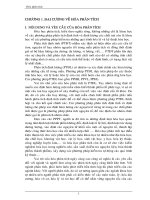SLIDE BÀI GIẢNG HÓA SINH vitamin
Bạn đang xem bản rút gọn của tài liệu. Xem và tải ngay bản đầy đủ của tài liệu tại đây (1.48 MB, 187 trang )
Trao đổi trực tuyến tại:
/>
Reading material
• Principles of Biochemistry with a Human
Focus by Garrett and Grisham, First
Edition, 2002, pages 453-468
• Handbook of NonPrescriptions Drugs,
11th edition, Chapter entitled “Nutritional
Products” by Loyd V. Allen, Jr.
Vitamins
• a group of organic compounds needed in small
quantities in the diet for normal activity of
tissues
• between 14 – 20 substances have been identified
as vitamins
• many vitamins act as cofactors, coenzymes or
prosthetic groups for enzymes
• most vitamins are derived from diet
• no calories are derived from vitamins
Vitamins
• first vitamin discovered was thiamine or
B1
• the term vitamin is derived from the fact
that the substances are needed for life
(vita) and because thiamine happened to
be an amine the term was coined as such
• however, not all vitamins are amines or
nitrogen containing compounds
Vitamins
• vitamin requirements are usually
expressed as RDA’s (recommended
dietary allowances)
• guidelines are provided by 2
organizations:
• the Food and Nutrition Board of the National
Academy of Sciences- National Research Council
• the Food and Drug Administration (FDA)
RDAs
• applications of RDAs include:
• evaluating the adequacy of the national food
supply
• establishing standards for menu planning
• establishing nutritional policy for public
institutions/organizations and hospitals
• evaluating diets in food consumption studies
• establishing labeling regulations
• setting guidelines for food product formulation
• developing materials for nutritional education
RDAs
• RDAs have limitations:
• they are too complex for direct consumer use
• they do not state ideal or optimal levels of intake
• the allowances for some categories are based on
limited data
• the data on some nutrients in foods is limited
• they do not evaluate nutritional status
• they do not apply to seriously ill or malnourished
patients
Vitamin deficiencies
• primary food deficiency
• crop failure
• food storage loss
• food preparation loss
• diminished food intake
•
•
•
•
poverty
anorexia
food fadism
chronic diseases
Vitamin deficiencies
• diminished absorption
• absorption defect
• parasites
• malignancies
• increased requirements
•
•
•
•
rapid growth
increased physical activity
pregnancy
hyperthyroidism
• increased loss
• drug therapy
• diuresis
• lactation
Vitamin loss
Loss is seen mainly in storage or food preparation
• Vitamin A: sensitive to oxygen and light
• Vitamin D: usually little loss
• Vitamin E: sensitive to oxidation especially
when heated or with alkali
• Vitamin K: sensitive to acids, alkali, light and
oxidizing agents
• Vitamin C: very sensitive to oxidation,
especially when heated in contact with metals
• Vitamin B complex: water solubility results in
loss in cooking water
• Riboflavin is sensitive to light
Vitamins
• Vitamins are typically divided into 2
groups:
– The fat soluble vitamins
• A, D, E, and K
– The water soluble vitamins
• The B vitamins (B1, B2, B3, B6, B7, B12 and
pantothenic acid)
• Ascorbic acid (vitamin C)
Bogus vitamins
•
•
•
•
•
•
•
Vitamin B4
Vitamin B10
Vitamin B11
Vitamin B15
Vitamin B13
Vitamin B17
Vitamin B19
adenine
identical with folic acid
“
“
“
“
pangamic acid
orotic acid
laetrile
wormser’s secret formula
Cofactors
• provide “chemical teeth” for enzymes
• sometimes referred to as coenzymes
• enzymes: proteins with catalytic activity
– simple enzymes: large protein (polypeptide) that
catalyzes a reaction. The enzyme gets all the “tools”
(chemical teeth) it needs from the amino acids.
However, there are only 20 different amino acids
– conjugated enzymes : apoenzyme + cofactor =
holoenzyme
EXAMPLE:Proteases: enzymes that cleave
peptide bonds
H
O
R'
H
N
N
N
R
H
H
H2O
R'
O
N
N
OH
O
H
protease
R
+
H2N
O
Enzymes perform catalytic reactions such as hydrolysis; the
side chains of amino acids participate in the reactions
example of a simple enzyme
Usually electron-rich
side chains are involved
in the catalysis
CH2OH
H
N
CH2
N
Aliphatic chains are
normally involved in
hydrophobic interactions
CH2-COOH
all these tools come from amino acids
in the protein active site
A serine protease enzyme such as chymotrypsin
HYDROLYTIC CATALYSIS
O
R'
N
NH
H
HN
COO-
N
O
ASP
N
H
R
HIS
COOH
ASP
SER
O-
HIS
SER
H2O
R'
R' NH2
O
N
HN
COO-
ASP
O
HIS
SER
NH
R
O-
HN
N
COOH
ASP
O
HIS
SER
R
Example of a conjugated enzyme
cofactor needed for reaction
Zinc protease such
as ACE
H
Zn+2
O
R'
OH
N
N
N
R
H
O
PRODUCTS + ENZYME
Cofactors
• all water-soluble vitamins with the exception of
vitamin C are converted/activated to cofactors
• only vitamin K of the fat-soluble vitamins is
converted to a cofactor
• not all vitamins are cofactors; i.e., lipoic acid is
not a vitamin
• cofactors may also act as carriers of specific
functional groups such as methyl groups and
acyl groups
The water soluble
vitamins
Pantothenic acid (vitamin B5)
H
CH3 OH
HO
CH2 C
CH3
CH C
N
CH2 CH2 COOH
O
First recognized in 1933 as a growth factor for yeast (Roger
J. Williams)
Pantothenic acid
• a yellow viscous oil (free acid)
• stable to moist heat (not to dry heat) and
to oxidizing and reducing agents
• hydrolyzed in acid or alkaline medium
• sources (numerous): liver, kidney, eggs,
lean beef, milk, molasses, cabbage,
cauliflower, broccoli, peanuts, sweet
potatoes, kale (derive its name from
everywhere)
Pantothenic acid
• serves in its activated form as the cofactor for
coenzyme A (CoA) and the acyl carrier protein (ACP)
• first phosphorylated by ATP to 4’phosphopantothenate
• next is the formation of 4’-phosphopantetheine by
addition of cysteine and decarboxylation
• adenylation by ATP forms dephospho-CoA
• phosphorylation to the 3’-OH of the ribose generates
CoA (coenzyme A)
H
O
N
S
O
Acetyl CoA
OH
H
H
N
N
N
O
O
SH
P
O-
O
O
NH2
O
O
P
N
O-
N
O
N
H2C
O
H
H
H
H
OPO3
Coenzyme A
OH
N
CH3
Coenzyme A
• performs a vital role by transporting acetyl
groups from one substrate to another
• the key to this action is the reactive thioester
bond in the acetyl form of CoA
• the thioester bond is stable enough that it can
survive inside the cell, but unstable enough that
acetyl-CoA can readily transfer the acetyl
group to another molecule
Example of an acetylation reaction
CH3
CH3
H3C
H3C
N
N
H3C
OH
H3C
choline
O
acetyl CoA
CoA
O
CH3
acetylcholine
Acetylcholine is an important neurotransmitter in
the autonomic nervous system (cholinergic) and in the brain









